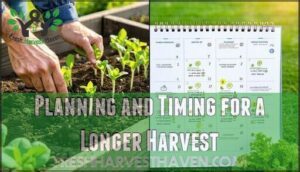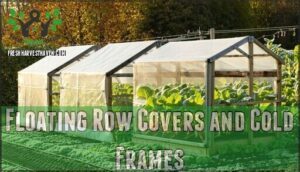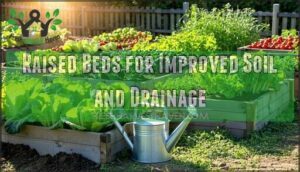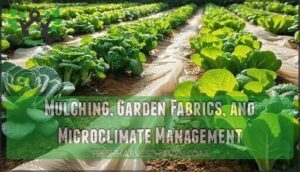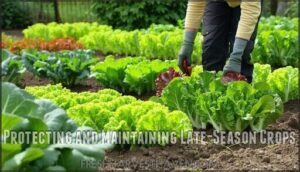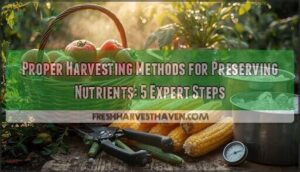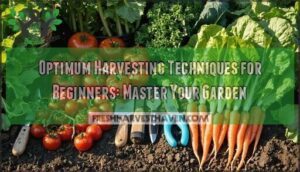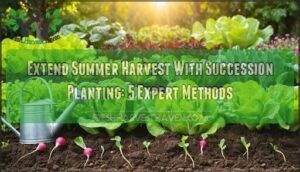This site is supported by our readers. We may earn a commission, at no cost to you, if you purchase through links.
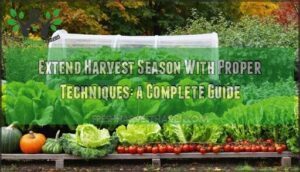
The difference between a garden that quits in September and one that feeds you through the cold months comes down to choosing the right crops, timing your plantings strategically, and creating protective microclimates that shield plants from harsh weather.
With a few targeted methods—from simple row covers to cold frames—you’ll transform your garden from a summer-only operation into a reliable food source that delivers fresh, nutrient-dense produce long after your neighbors have cleared their beds.
Table Of Contents
- Key Takeaways
- Benefits of Extending Your Harvest Season
- Choose The Right Crops for Season Extension
- Planning and Timing for a Longer Harvest
- Effective Season Extension Methods
- Protecting and Maintaining Late-Season Crops
- Frequently Asked Questions (FAQs)
- How can I extend my growing season?
- How do you increase harvest?
- What is the proper method to harvest the plants?
- What is the meaning of extended growing season?
- How can you extend the growing season?
- What is the season extension farming?
- Do row covers extend the growing season?
- How can I manage pests in extended seasons?
- What are cost-effective tools for beginners?
- How do I rotate crops for sustainability?
- Conclusion
Key Takeaways
- Extending your harvest season beyond summer requires three key elements: selecting cold-hardy crops that thrive in cooler temperatures, timing plantings strategically through succession planting every 2-3 weeks, and using protective structures like cold frames or row covers that add 2-7°F of frost protection.
- The difference between a garden that ends in September and one producing through winter comes down to matching crops to conditions—frost-tolerant vegetables like kale, spinach, and Brussels sprouts actually taste sweeter after frost and can be harvested months later than summer crops with proper protection.
- Season extension delivers measurable benefits beyond just more food: fresh-picked produce retains peak nutrition (you lose 51% of vitamin C in green peas within 24-48 hours of harvest), reduces dependency on supply chains, and transforms your garden from a hobby into a reliable year-round food source.
- Success with late-season crops depends on active management—monitoring soil health as temperatures drop, adjusting watering as evaporation slows, scouting for pests that shift to fall crops, and harvesting at peak ripeness before properly storing produce in cool, dark conditions for winter use.
Benefits of Extending Your Harvest Season
Stretching your harvest season beyond summer’s peak opens up real advantages you won’t want to miss. From enjoying fresh produce longer to building genuine food independence, the benefits touch both your table and your gardening confidence.
Here’s what you gain when you master season extension techniques.
Increased Harvest Time and Fresh Eating
When you stretch your growing season beyond the typical summer months, you gain the chance to eat fresh-picked vegetables and fruits for weeks or even months longer than your neighbors. Succession planting techniques and staggering the harvests mean you’re not overwhelmed with produce all at once, minimizing food waste while maximizing fresh food access.
Here’s what extending the harvest season delivers:
- Peak nutritional value retention from harvesting fresh food at its prime
- Extended harvest benefits that keep your table supplied into late fall or winter
- Reduced dependence on store-bought produce through eating local produce year-round
- Better flavor and quality compared to preserved or shipped alternatives
Extending harvest through the winter transforms your garden from a summer hobby into a reliable food source.
Greater Variety of Crops Grown
A longer growing window doesn’t just mean more tomatoes—it opens the door to cultivating cool-season crops like kale, Brussels sprouts, and carrots that actually thrive when temperatures drop.
Crop diversification through succession planting techniques lets you rotate fast-maturing greens with slower storage varieties, creating market opportunities with unique cultivars and regional specialties that extend harvest through the winter.
| Season | Crop Type | Example Varieties |
|---|---|---|
| Spring | Cool-season starters | Lettuce, spinach, peas |
| Summer | Heat-lovers | Tomatoes, peppers, beans |
| Fall/Winter | Cold-hardy crops | Kale, carrots, Brussels sprouts |
Enhanced Self-Sufficiency and Food Security
Growing your own food year-round shifts you from being a grocery store customer to your own produce provider, cutting your dependency on supply chains that can be disrupted by weather, fuel costs, or distribution problems.
Year-round gardening transforms you from grocery store customer to self-sufficient producer, free from vulnerable supply chains
Season extension builds genuine food sovereignty through:
- Reduced food miles that lower your environmental footprint
- Long-term food storage of homegrown crops
- Community resilience when you share surplus harvests
- Sustainable agriculture practices that support local food systems
Homesteading strategies for extending the harvest season let you harvest fresh food even when store shelves run low.
Nutritional Advantages of Fresh Produce
Beyond self-sufficiency lies something even more valuable—peak nutrition. When you harvest fresh food straight from your vegetable garden, you’re capturing the benefits of eating fresh produce at its nutritional prime.
| Nutritional Component | Fresh Harvest Peak | Loss After Storage |
|---|---|---|
| Vitamin C (green peas) | Immediate after picking | 51% within 24–48 hours |
| Fiber Content (medium apple) | 4.4 g with skin | Stable but quality declines |
| Antioxidant Activity (berries) | Highest at ripeness | Decreases in storage |
| Disease Reduction Potential | Best when consumed fresh | Diminishes as nutrients degrade |
Your extended harvest lets you eat organic produce minutes after picking, before nutrient loss begins. Access to fresh produce has a real impact—people receiving regular fresh vegetables increased their daily consumption and improved blood sugar levels within months. Studies show that access to fresh produce can improve diet and physical activity.
Choose The Right Crops for Season Extension
Not every vegetable thrives when you push the growing season beyond its comfort zone. Your success depends on matching crop choices to the cooler temperatures and shorter days that come with season extension.
Let’s look at which plants can actually deliver when you’re stretching your harvest into early spring or late fall.
Cool-Season and Cold-Hardy Vegetables
You can’t stop winter, but you can work with it. Cool-season crops and cold-hardy vegetables thrive in cooler soil temperatures, making them ideal for extending your harvest season into fall and winter.
Frost-tolerant varieties like kale, spinach, and Brussels sprouts actually taste sweeter after frost exposure. Plant these fall crops in late summer for winter harvest timing, and focus on bolting prevention through proper spacing and consistent moisture.
With smart pest management and attention to soil temperature impact, you’ll enjoy fresh winter vegetables long after summer crops fade. Knowing the ideal soil temperature is critical for planting.
Fast-Growing and Long-Season Crops
Balancing speed and stamina in your garden gives you the best of both worlds—quick wins from radishes and lettuce alongside steady producers like tomatoes and winter squash. Here’s how to get the most out of continuous production:
- Plant rapid-cycling crops like arugula and bush beans for quick harvests every few weeks through succession planting.
- Choose early maturity varieties of cool-season crops to harvest before your main-season plantings hit their stride.
- Invest in extended yield types like indeterminate tomatoes and pole beans that keep producing until frost ends their run.
Your planting schedule should weave both crop varieties together for nonstop harvests.
Perennial and Storage Crops
When perennials like asparagus and rhubarb meet storage champions like winter squash and root crops, you’ve built a food system that works year after year with minimal replanting effort.
Growing perennial plants and perennial herbs establishes crop longevity, while root vegetables excel at winter storage through root cellaring techniques.
| Perennial Vegetables | Storage Crops |
|---|---|
| Asparagus, rhubarb, artichokes | Winter squash, potatoes, onions |
| Harvest for 10-20+ years | Longterm storage: 3-8 months |
| Minimal replanting | Perfect for longterm food storage |
Combining both types strengthens your seed saving program and year-round self-sufficiency.
Selecting Suitable Varieties and Seeds
Choosing vegetable seeds means matching maturity timeframes, disease resistance, and regional adaptation to your local climate and goals. High-yield types bred for your hardiness zone mature faster and produce more, extending the growing season with reliability you can count on.
- Early-maturing varieties (55–60 days) fit short seasons and enable succession plantings
- Disease-resistant cultivars cut crop loss by 30–60% and reduce pesticide needs
- High-yield types deliver 35–50% more produce per plant than standard seeds
- Fresh, certified seed from reputable sources ensures 80% fewer contamination risks and strong germination
Planning and Timing for a Longer Harvest
The secret to a longer harvest isn’t just what you grow—it’s when and how you plant it. Smart timing transforms a garden that feeds you for a few weeks into one that produces from spring frost to winter freeze.
Let’s look at the key strategies that keep your harvest rolling in.
Succession Planting Techniques
Think of succession planting as your secret weapon for keeping the harvest flowing—you’re basically planting the same crop multiple times at staggered intervals. Start seedling starts every two to three weeks for continuous harvest rather than one massive haul.
Proper soil preparation between plantings and strategic crop spacing make sure each wave thrives. These succession planting strategies work beautifully for lettuce, beans, and radishes, giving you late-season plantings that keep producing well into fall.
Creating a Planting Calendar
A planting calendar turns guesswork into a game plan, mapping out exactly when to sow, transplant, and harvest so you’re not scrambling or missing your window. Build yours around these factors:
- Planting zones and local frost dates anchor your entire timeline
- Succession timing intervals (every 2-3 weeks) for continuous harvest
- Crop maturity and timing details from seed packets guide scheduling
- Microclimate impacts like south-facing beds or sheltered spots
- Crop grouping by family and growing requirements simplifies garden planning
Calendar software or even a simple spreadsheet helps you track planting multiple crops and execute succession planting strategies for fall crop planting success.
Staggering Harvests and Crop Rotation
Once your calendar’s built, you’ll want to stagger when crops mature and rotate plant families through your beds to keep soil healthy and avoid the feast-or-famine cycle.
Succession planting strategies involve planting multiple crops at intervals, ensuring a continuous harvest rather than all at once. Crop rotation shifts plant families—legumes, brassicas, nightshades—to different beds each season, preventing nutrient depletion and breaking pest cycles.
| Rotation Benefit | How It Helps |
|---|---|
| Soil health | Different crop families use varying nutrients |
| Pest control | Disrupts insect life cycles and reduces disease buildup |
| Improved yields | Balanced nutrient availability fosters stronger growth |
| Extended harvest | Staggered maturity dates keep produce coming |
| Better planning | Organized bed assignments simplify succession planting |
This combination keeps your garden productive, stretching the harvest well into fall while maintaining long-term soil vitality.
Late Summer and Fall Plantings
By late summer, your beds are ready for a second wave—cool-season crops that thrive as temperatures drop and daylight shortens. Extending harvest season through late-season plantings requires proper soil preparation and smart fall crop selection:
- Plant fast-maturing varieties like spinach, radishes, and lettuce 6–8 weeks before your first frost date
- Choose cold-hardy options including kale, carrots, and turnips that improve flavor after light frosts
- Manage fall pests early through crop rotation and floating row covers for healthier fall harvest yields
Effective Season Extension Methods
When you’re ready to push beyond your region’s natural growing limits, a few well-chosen tools can make all the difference. The right structures create protective environments that shield your crops from harsh weather and add weeks or even months to your harvest window.
Here’s what works best for extending your season.
Using Greenhouses, High Tunnels, and Hoop Houses
When you’re ready to take full command of your growing season, greenhouses, high tunnels, and hoop houses deliver powerful protection from weather extremes. These season-extending techniques can shield plants and stretch your gardening calendar by two to six months, giving you mastery over Mother Nature’s timeline.
| Structure Type | Key Considerations |
|---|---|
| Greenhouse Materials | Glass, polycarbonate, or polyethylene panels; aluminum or wood framing |
| Tunnel Ventilation | Roll-up sides, end vents, or automated fans for temperature control |
| Hoop House Costs | Budget-friendly DIY options starting around $300–$500 for small setups |
| Heating Options | Passive solar, electric heaters, or propane systems for frost protection |
| Pest Management | Monitor humidity, use screens, practice crop rotation, encourage beneficials |
Growing under cover means you control the microclimate—temperature, humidity, and airflow all bend to your will.
High tunnels offer excellent ventilation without heating costs, while greenhouses provide year-round possibilities with proper heating options.
Floating Row Covers and Cold Frames
If you want a simpler, lower-cost approach that still packs serious frost-fighting punch, floating row covers and cold frames give you flexible protection without the commitment of permanent structures. Row covers deliver a frost protection factor between 2–7°F, enabling earlier or later harvesting periods for many crops while also excluding pests.
Cold frames create their own microclimate, warming soil and protecting plants from frost—just remember to vent on sunny days to prevent overheating.
Raised Beds for Improved Soil and Drainage
Raised beds don’t just lift your plants—they warm your soil faster in spring, drain excess moisture, and give you complete control over growing conditions from the ground up. By constructing beds 8–12 inches high using untreated wood or stone, you create microclimates that improve soil conditions and enable earlier planting techniques.
Better drainage and soil insulation mean healthier roots and extended productivity.
Mulching, Garden Fabrics, and Microclimate Management
Mulching and garden fabrics work like a second skin for your soil, trapping warmth, locking in moisture, and creating pockets of protected space that let you push your harvest weeks beyond what nature alone allows.
Apply 2–4 inches of organic mulch for soil insulation and moisture retention, then layer garden fabric over vulnerable crops to control microclimates. These season-extending techniques raise soil temperature by several degrees and shield plants from wind and cold.
Protecting and Maintaining Late-Season Crops
Once you’ve stretched the season with structures and timing, your next challenge is keeping those late-season crops healthy and productive as temperatures drop. Protection from frost, maintaining soil vitality, and staying ahead of pests become critical when plants are pushing their limits.
Here’s how to safeguard your extended harvest through fall and into winter.
Frost Protection Strategies
Protecting plants from frost is like building a safety net for your extended season. Row covers deliver a frost protection factor between 2–7°F, enabling earlier or later harvesting periods for many cold-hardy plants.
Combine cover materials with strategic site selection and irrigation methods—overhead watering can actually shield crops during unexpected cold snaps. These frost protection techniques transform your season-extending capabilities.
Managing Soil Health and Watering Needs
Healthy soil and consistent moisture work like fuel for your late-season crops—without them, even the hardiest plants struggle to deliver quality harvests. Test pH balance and add soil amendments to replenish nutrients depleted by summer crops.
Mulch regulates soil temperature and aids water conservation while improving drainage solutions.
Adjust watering needs as cooler weather slows evaporation—managing your garden environment means matching moisture to crop demands, not following rigid schedules.
Monitoring Plant Health and Pest Control
Late-season gardens don’t run on autopilot—pests can shift their focus to your tender fall crops faster than you’d expect, and disease prevention becomes critical when cool nights meet warm days. Scout regularly for pest identification and catch problems early.
Integrated management combines organic solutions with crop protection strategies that support disease resistance. Managing plant health means maintaining soil health and adjusting your approach as conditions change, not waiting until damage appears.
Harvesting and Storing Crops for Winter Use
Pull your crops at peak ripeness and you’ve won half the battle—the other half is storing them properly so they’ll nourish you through winter.
Root vegetables and winter squash need curing before long-term preservation in proper storage conditions—think cool, dark spaces with controlled humidity. Root cellar design matters for fall gardening techniques, while fermentation techniques transform harvest season surplus into nutrient-dense winter vegetables that’ll last months.
Frequently Asked Questions (FAQs)
How can I extend my growing season?
One Vermont farmer harvested spinach through December by combining cold frames with row covers—that’s three extra months of greens.
You can extend your growing season by using season-extending techniques like cold frames, greenhouses, and frost protection techniques to shield crops from weather extremes and harvest fresh produce longer.
How do you increase harvest?
You increase harvest by maximizing yield through succession planting, optimizing fertilization, boosting planting density with vertical gardening, and extending harvest into fall with season-extending techniques for higher crop yield and harvest frequency.
What is the proper method to harvest the plants?
Think of harvest timing like picking fruit at peak ripeness—too early or late diminishes value. Use crop-specific harvesting methods and best timing for each variety.
Treat produce carefully during spring harvest and late-season plantings, preparing them properly for storage to extend your harvest season into fall.
What is the meaning of extended growing season?
An extended growing season means pushing beyond natural seasonal limits to grow and harvest food longer than your climate’s typical frost-free season allows.
Using season-extending techniques enables year-round growth and improved food availability.
How can you extend the growing season?
You can extend the growing season through season-extending techniques like greenhouses, hoop houses, and cold frames that shield crops from weather extremes.
Floating row covers and raised beds offer protection methods for blocking spring and fall frosts while managing garden environment conditions effectively.
What is the season extension farming?
Season extension farming uses season-extending techniques like hoop houses, cold frames, and frost protection techniques to grow crops beyond natural limits.
These Modern Extension Practices let you cultivate Winter vegetable gardening year-round through Cool-season crop management.
Do row covers extend the growing season?
Row covers deliver a frost protection factor between 2–7°F, effectively extending your growing season by shielding crops from early and late frosts.
These season-extending techniques enable earlier spring planting and delayed fall harvests through practical weather protection.
How can I manage pests in extended seasons?
Aphids multiply like rabbits under plastic—warm, humid environments become pest havens.
Combat this with beneficial insects, trap cropping, and organic pesticides. Install pest barriers and practice crop rotation.
Monitor cool-season crop management closely, as protecting late crops requires vigilant pest control when using season-extending techniques for late-season plantings.
What are cost-effective tools for beginners?
Start small with DIY cold frames using old windows or upcycled materials. Row covers and mulch cost little but protect crops effectively. Low tunnels from PVC pipes and garden fabric work well.
Try seed starting in reused containers, and explore community gardens for shared season-extending techniques and low-cost irrigation resources.
How do I rotate crops for sustainability?
Rotate plant families through different beds each year. This breaks pest cycles, balances soil nutrient demands, and prevents disease buildup.
Follow heavy feeders with legumes or cover crops to restore nitrogen naturally.
Conclusion
Timing matters more than most gardeners realize. Plant your fall crops three weeks too late, and frost wins. Start them three weeks early, and you’re harvesting spinach in January while your neighbors buy wilted greens at the store.
When you extend harvest season with proper techniques, you’re not just growing food longer—you’re building a system that produces through conditions that would normally end the game. Your garden becomes a year-round asset, not a summer hobby that disappears when temperatures drop.
- https://pubs.nmsu.edu/_h/H251/
- https://efotg.sc.egov.usda.gov/references/public/SC/NC_SeasonExtension_principles.pdf
- https://homesteadingfamily.com/learn-to-extend-the-growing-season/
- https://twin-cities.umn.edu/news-events/inside-track-increased-food-production
- https://pmc.ncbi.nlm.nih.gov/articles/PMC10417803/


